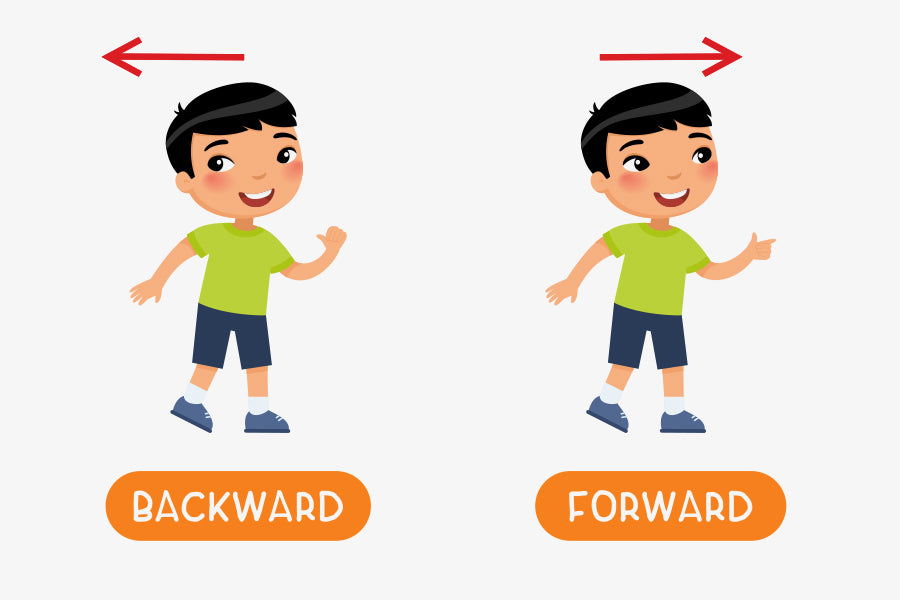Backward walking has been gaining popularity in recent years as a way to improve balance, coordination, and stability. This exercise can benefit people of any age or fitness level and is an excellent way to challenge your body.
Backward walking is a form of gait retraining that involves the conscious effort to move your body in the opposite direction. It requires greater focus and coordination than regular walking because you constantly adjust your movements because you don't have eyes in the back of your head.
You should also pay close attention to your body position while performing this exercise to ensure that your posture is correct.
It is important to note that backward walking should only be attempted with proper instruction and supervision by a qualified professional. Proper instruction will help you avoid potential injuries, such as strains on the back or legs.
This article will explore the mental and body benefits and how you can incorporate them into your workout routine.
Related Article: Top 5 Walking Variations for Your Future Cardio Sessions
Physical Benefits of Walking Backward
Some of the physical benefits of walking backward include the following:
Serves as a Cardiovascular Exercise
Walking backward is a great way to work out because it provides an effective cardiovascular workout. It requires you to use more muscles than usual, which can lead to improved muscle strength and coordination.
Balance & Proprioception
Walking in reverse increases the intensity of your exercise routine by challenging your balance and proprioception, the ability to sense body position, movement, and spatial orientation. This can help enhance overall coordination and agility while providing additional calorie-burning benefits.
Reduces Joint Pain
By engaging different muscle groups when compared with forward walking or running, walking backward may be better for reducing joint pain or minimizing wear and tear on specific body areas.
Mobility & Stability
Physically, it can improve balance, coordination, stability, and strength in the legs and core muscles. It can also help increase hip and ankle mobility, reducing lower back pain.
Rehabilitates Injuries
Backward walking can also be used to help rehabilitate injuries or improve mobility. By incorporating this exercise into your physical therapy program, you will be able to regain strength and mobility, which can make a significant difference in your everyday life.
Increases Endurance
Lastly, walking backward helps increase endurance. With all these physical benefits, it’s no surprise that walking backward is becoming popular.
Mental Benefits of Walking Backward:
Beyond the physical benefits, mental health benefits are also associated with walking backward.
Improves Creativity
Walking in reverse can help improve creativity and problem-solving skills by challenging you to think outside the box.
Boosts Self-Confidence
It can help boost self-confidence due to the sense of accomplishment from mastering something new while walking backward.
Helps in Distracting Mind
Lastly, because it requires more concentration than traditional walking or running, it helps to distract your mind from anxieties or worries, allowing you to gain much-needed perspective on any situation.
Incorporating Backward Walking Into Your Workout Routine
Backward walking can easily be incorporated into any workout routine at the gym or home. It is essential, to begin with, short distances and increase them gradually as you become more comfortable with the exercise.

Getting started with backward walking is relatively simple and can be done anywhere that's safe.
- Start by standing upright with your feet hip-width apart, then take a few steps backward.
- It is essential to move slowly and deliberately, as this will help you ensure that your form is correct and prevent any injuries from happening.
- Additionally, it can be helpful to practice in front of a mirror so you can see how your body moves and make adjustments if needed.
Once you become comfortable moving backward, challenge yourself by increasing the distance or adding obstacles to the path.
It is always important to listen to your body when exercising and stop if you feel any pain or discomfort.
If necessary, consult a qualified medical professional if you experience any ongoing issues or have any questions or concerns.
Backward walking is an excellent way to challenge your body and mind while improving overall well-being. With patience and dedication, you can reap this exercise's numerous benefits!
Related Article: Bodyweight Workouts: 16 Best Bodyweight Exercises for Beginners
Variations of Walking Backward
Walking backward is an excellent form of exercise that can help improve core strength, balance, and coordination. It can also be used as a form of rehabilitation or physical therapy for injuries such as ankle sprains or hip pain. Several different variations of walking backward can be used:
1. Lateral Walking

This variation involves walking directly sideways while maintaining the same basic posture and taking alternating steps with each foot. As you move your feet in this manner, you must keep your torso straight and focus on engaging your abdominals and lower-back muscles to remain balanced.
How to Do It?
- Begin by standing with your feet slightly wider than shoulder-width apart.
- Start by taking a step to the side using your right foot while keeping your left leg in place, and repeat this motion on the opposite side.
- As you do this movement, focus on pushing off from the ground with each step while maintaining balance and control throughout the entire movement.
2. Curtsy Box Step-Overs

In this variation, use a box to step on and over. This is a challenging movement and takes a lot of coordination and stability to complete.
How to Do It?
- Place a box or a step on the floor beside you. To make it more challenging you can hold a weight with both hands at your chest.
- Take your opposite side leg and cross it over your other to step it on the box.
- Step up, fully extending your hips, taking your other leg with you. Hoover the other leg over to the other side of the box and land softly.
- Repeat for the duration of the set and then switch legs.
3. Diagonal Walking

This variation involves taking significant diagonal steps backward, maintaining a wide stance the whole time.
How to Do It?
- Begin by standing with your feet slightly wider than hip-width apart, and take a significant step backward and to the side with the right foot.
- Then, bring the left foot over to meet it while maintaining balance throughout the movement.
- As you do this exercise, focus on engaging your abdominals and glute muscles to maintain stability and control throughout each step.
4. Step Up/Step Down

This variation requires starting by stepping onto a platform or bench with one foot before stepping back down with the other while maintaining the same basic posture throughout the movement. Focus on using your core strength to remain balanced while performing this variation.
How to Do It?
- Start by standing just in front of a platform or bench and step up onto it with your right foot.
- As you do this, use the power generated from your left leg to push off the ground and help maintain balance.
- Then, as you bring your left foot back down to the ground, focus on engaging your core muscles to remain balanced throughout the entire movement.
- Repeat this same pattern with each foot for a complete set.
Physiological Differences Between Walking Forward and Backward
There are several physiological differences between walking forward and backward. For example, when you move backward, your feet point inwards towards each other, which engages different muscles than those used for regular walking.
Additionally, the direction of movement requires more outstanding balance and coordination as your body must quickly adjust to any changes or obstacles.
Finally, backward walking also works different muscles in your core area since you need to maintain an upright posture while moving against gravity. These factors help ensure a more comprehensive workout when incorporating backward walks into your exercise routine.
On the mental side, reverse walking can help improve focus and concentration while providing an opportunity to practice mindfulness. This type of exercise can also help sharpen reflexes and reaction time.
Furthermore, backward walking can also benefit those looking to recover from injuries or improve mobility.
Finally, because of its impact on core muscles, backward walking can also positively reduce lower back pain. When done correctly with good form and posture, backward walking can help strengthen your abdominal and lower back muscles which help alleviate discomfort and pressure on your spine.
Backward walking is generally safe when practiced in moderation. However, it may only be suitable for some. It is essential to discuss any exercise plans with your doctor before beginning and make sure that you are healthy enough to participate.
Individuals with a history of joint pain or mobility issues should proceed cautiously and seek medical advice if needed. Pregnant women should also avoid this type of exercise as it could lead to injuries due to balance changes and weakened abdominal muscles.
Forward walking can provide similar benefits without requiring more intensive coordination skills.
Conclusion
Backward walking is a simple but effective way to improve balance, coordination, and stability. Incorporating this exercise into your regular fitness routine can increase your overall physical performance and help reduce the risk of falling or injury.
The ability to move in different directions is essential for sports, work, and daily activities. Whether you are an athlete or an elderly person, backward walking can improve your balance and stability.
In conclusion, backward walking can offer numerous benefits for both physical and mental health when practiced correctly. If this exercise is proper for you, remember to increase the intensity gradually over time.
Be sure to listen to your body and stop if you experience pain or discomfort. Finally, always consult a qualified medical professional before beginning an exercise program to ensure that you can participate safely and effectively.
Reading List
Article Sources
- Ansari, Bushra, et al. “Lumbar Muscle Activation Pattern During Forward and Backward Walking in Participants With and Without Chronic Low Back Pain: An Electromyographic Study.” Journal of Chiropractic Medicine, vol. 17, no. 4, Dec. 2018, pp. 217–25. PubMed Central, https://doi.org/10.1016/j.jcm.2018.03.008.
- Balasukumaran, Tharani, et al. “The Effectiveness of Backward Walking as a Treatment for People with Gait Impairments: A Systematic Review and Meta-Analysis.” Clinical Rehabilitation, vol. 33, no. 2, Feb. 2019, pp. 171–82. PubMed, https://doi.org/10.1177/0269215518801430.
- Cha, Hyun-Gyu, et al. “Therapeutic Efficacy of Walking Backward and Forward on a Slope in Normal.” Journal of Physical Therapy Science, vol. 28, no. 6, June 2016, pp. 1901–03. PubMed Central, https://doi.org/10.1589/jpts.28.1901.
- Flynn, T. W., and R. W. Soutas-Little. “Mechanical Power and Muscle Action during Forward and Backward Running.” The Journal of Orthopaedic and Sports Physical Therapy, vol. 17, no. 2, Feb. 1993, pp. 108–12. PubMed, https://doi.org/10.2519/jospt.1993.17.2.108.
- Ju, Sung Bum. “Analysis of the Pain Relief Effect of Walking Backwards Down on a Steep Slope in Patients with Plantar Fasciitis.” Iranian Journal of Public Health, vol. 50, no. 10, Oct. 2021, pp. 2139–40. PubMed Central, https://doi.org/10.18502/ijph.v50i10.7518.
- Terblanche, E., et al. “The Effect of Backward Locomotion Training on the Body Composition and Cardiorespiratory Fitness of Young Women.” International Journal of Sports Medicine, vol. 26, no. 3, Apr. 2005, pp. 214–19. www.thieme-connect.com, https://doi.org/10.1055/s-2004-820997.








